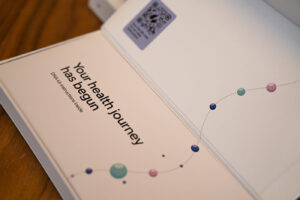 Credit: piyaset / iStock / Getty Images Plus
Credit: piyaset / iStock / Getty Images Plus
On January 27, 2011, a video called Making Medicine Personal aired with three customer testimonials that all shared a successful experience at the hands of personalized genomics.
In the first, an older white man explains how he gave his doctor his genomic testing results, which led to a diagnosis that would save his life. In the second, a middle-aged white woman shares how, over 15 years, doctors failed to properly diagnose her, but all that changed when she signed up for personal genomic testing, which pinned down the diagnosis. In the third, an older white man compares his prostate exam results supplied by his doctor with his genomic testing profile and is able to conclude that he probably has prostate cancer.
That was a commercial from 23andMe (Box 1). This raises the question: How has there not been a personal genomics revolution in healthcare in the past 14 years, and where are we now?
In this three-part series, I will dive into the realm of personal genomics, which is experiencing a transformative resurgence. In Part 1, I interview the CEOs of an array of genetic testing companies to get a sense of the role of DNA sequencing in personalized healthcare, primarily focusing on the differences between direct-to-consumer (DTC), provider-mediated, and clinician-initiated models. In Part 2, I share my experiences with using a handful of these personalized genomics tests, all whole genome sequencing (WGS) and one microarray, from both the DTC and clinician-initiated sides. Finally, in Part 3, I offer thoughts on the direction of genomics in healthcare and medical research.
We’re all adults here
Kian Sadeghi has a captivating, Bill Gates-esque story of a young college dropout and technology whiz turned founder. His motivation stems from a family tragedy—his cousin died in her sleep due to what was belatedly discovered to be a rare genetic cardiac disorder. The mission to save people like his cousin is why Sadeghi says he founded the personal genomics company Nucleus Genomics.
According to Sadeghi, there has historically been a false dichotomy between clinical genetics and consumer-initiated genetics companies like 23andMe. He believes that this confusion is the result of decisions made by initial DTC genomics companies that were limited by the cost of sequencing a genome, which, in turn, dramatically limited the interpretability of the data.
 Kian Sadeghi
Kian Sadeghi
CEO and co-founder
Nucleus Genomics
“If you go back to 2006, when the cost of reading a whole genome was $10 million a sample, you can’t sequence a person’s genome commercially,” Sadeghi told Inside Precision Medicine. “So, you have a choice: microarrays, gene panels, or sequencing small slivers of DNA. … The consumer companies went with microarray technology, while the clinical companies went with gene panels. But if you use microarray technology like 23andMe, you can’t identify the most consequential hereditary disease markers.”
Today, New York-based Nucleus Genomics is selling consumer-initiated, provider-mediated kits that are not currently covered by insurance (but are HSA/FSA eligible) for a few hundred dollars, a figure Sadeghi believes will drop further still. The clinical-grade Nucleus DNA Health Test, which goes for $499, performs whole-genome sequencing at 30x coverage to screen for more than 24 common diseases, around 900 rare diseases, and, as a bonus, traits. It also includes Nucleus Family, a carrier screening analysis that analyzes hundreds more genes than even the largest panels today. That’s a major jump from the microarray days of 23andMe and Ancestry not many years ago.
The goal at Nucleus, Sadeghi said, is to empower consumers in healthcare, aligning with a broader societal movement toward greater personal agency. This approach, Sadeghi believes, could redefine the doctor-patient dynamic, shifting from what he calls a paternalistic model to a partnership aimed at proactive, preventative care. “By starting with the consumer, you implicitly give them agency and treat them like adults,” Sadeghi said.
Sadeghi criticized the current system, where insurance often only supports genetic testing after a disease is diagnosed. “The largest insurer might cover a genetic test for cancer only after a woman gets breast cancer—that’s crazy,” said Sadeghi. Noting the inefficiency of waiting for insurers to adopt cutting-edge technology and predicting that genome sequencing will soon become so affordable that it will bypass traditional healthcare systems entirely, he said, “The cost of genome sequencing is dropping so rapidly that it will shortly be ubiquitous and inexpensive, requiring no insurance coverage at all.”
From DTC to healthcare systems
When James Lu, MD, PhD, founded Helix a decade ago, he started with the DTC genomics model. But over time, he shifted the company to focus on population genomics rooted in a desire to drive meaningful healthcare outcomes. Reflecting on his experience, Lu highlights two key challenges with the DTC model.
First, Lu believes that the transactional nature of DTC genomics creates problematic incentives. Companies often market report volume, which requires a consistent need for more content. “When your incentive model is to have more reports, you will constantly ask, ‘What is the minimum scientific requirement to create a new report?’” Lu explained. If you need to increase the number of reports, you inevitably have to include more marginal studies to be competitive. For Lu, a physician and scientist, this approach conflicts with the goal of delivering valid and useful genomic insights.
 James Lu, MD, PhD
James Lu, MD, PhD
CEO and co-founder
Helix
The second issue has to do with turning genomics insights into actions, which requires navigating a complex healthcare system. “If I tell you something about the risk of X, Y, Z … I actually have to go to work in the healthcare system to get them to do the things I need done,” Lu noted. Without systemic support, individuals face barriers to accessing care, leading to missed opportunities for intervention. For instance, when women receive BRCA mutation results but lack system-level follow-through, “70% of those patients will get lost in follow-up within a year,” said Lu.
Helix’s pivot to population genomics focuses on integrating genomic insights into healthcare workflows to ensure actionable outcomes. “When we work with the health system, we spend only a little bit of time talking about genomics and most of our time talking about workflow,” Lu stated. This task involves coordinating referral pathways, genetic counseling, access to additional screening, and follow-ups—essential components for timely and effective care. He emphasized that “95% of that is not genetics. This care is fundamental, consisting of a patient’s initial consultation, ongoing monitoring, and subsequent treatment.
To this end, for screening purposes, Helix mostly focuses on CDC-defined Tier 1 genomic applications—those with the most evidence to support their early detection and intervention for public health impact: hereditary breast and ovarian cancer, Lynch syndrome, and familial hypercholesterolemia. Helix has teamed up with several health systems to create programs offering free whole-exome sequencing for 100,000+ individuals, such as Tapestry with Mayo Clinic, In Our DNA SC with the Medical University of South Carolina, and The Healthy Nevada Project with Renown IHI.
Less is more
On the scale of DTC evangelist to non-believer, Giordano Bottà, PhD, Allelica CEO and co-founder, is basically an anti-theist. “Most DTC tests do not have clinical value,” Bottà told Inside Precision Medicine. “They often provide information on traits such as IQ, that don’t have real medical impact and their predictive performance is very poor, harming the field by creating confusion. It’s extremely difficult for individuals to understand what level of testing they’re getting and whether it’s actually useful for them.”
Instead, Bottà’s mission with Allelica is to fully capitalize on the use of polygenic risk scores (PRS) for actionable clinical care to prevent common diseases with significant genetic components (Box 2). Allelica is not unique in using PRS, but Bottà is keen on targeting only a few major health challenges. Whereas Nucleus Genomics reports on over 900 disease risks—as of June 2025, only 91 were classified as actionable by the American College of Medical Genetics and Genomics—Bottà has focused Allelica on just a few common diseases, such as coronary artery disease, breast cancer, prostate cancer, type 2 diabetes, and Alzheimer’s disease, by helping physicians identify patients at high risk, often invisible to traditional risk models.
“Up to 30% of heart attacks occur in people without traditional risk factors,” Bottà explains, emphasizing the gap in current care. PRS, validated across diverse ancestries, allows reclassification of patients in borderline or intermediate risk categories into actionable groups. “We identify increased risks that are clinically actionable, like a two- or three-fold increase comparable to familial hypercholesterolemia,” he noted.
Emphasizing precision over mass-market approaches, Bottà contrasts Allelica’s physician-led model with DTC testing, which he says lacks both scientific rigor and clinical relevance. Bottà said, “Consumer tests often overgeneralize risks, such as presenting a 2% lifetime risk as ‘high,’ which confuses users and undermines the field.” Bottà, critical of DTC’s inability to incorporate nuanced clinical decision-making, said, “Managing high-risk patients requires empathy and a personalized approach that cannot be replaced by handing information directly to consumers.”
 Nucleus Genomics Kit
Nucleus Genomics Kit
Allelica focuses on integrating PRS into existing clinical workflows to enhance prevention. For example, in cardiovascular care, PRS can intervene earlier than traditional tools like calcium scores by identifying plaque formation risks before disease progression. This, Bottà highlights, is real and immediate “precision medicine in action,” where patient thresholds like LDL cholesterol are adjusted based on genetic predispositions.
Can anyone use a personal genomic test?
MyOme CEO Premal Shah, PhD, is outspoken about the shortcomings of many genetic testing companies, particularly those touting extensive gene counts in their reports. “I see reports all the time where people claim 800–1,000 genes,” Shah said. “But we prioritize quality over quantity. We constantly reevaluate our gene reports. For example, we recently updated from an 81-gene to a 151-gene report after careful analysis by our clinical team. If a gene cannot be properly communicated to a patient for actionability, we won’t include it. That’s the rigor we take.”
But perhaps the biggest question for Shah, regardless of whether the business model is DTC, goes back to the 23andMe commercial I mentioned at the beginning—they were three white people. For MyOme to be a success, Shah believes that everyone has to be able to benefit from the tests, including himself. “As an Indian male with inherent cardiac risk, I know how much this matters—to me, my family, and others I care about,” he shares. This ethos underpins MyOme’s mission to deliver meaningful, preventative insights tailored to diverse populations.
 Premal Shah, PhD
Premal Shah, PhD
CEO, MyOme
Shah criticizes the widespread use of unvalidated PRS models, often adapted from online repositories without proper consideration of ethnic and ancestry differences. “Most clinical models, like Framingham or the current iteration called the ASCVD calculator, were developed on predominantly Caucasian cohorts,” Shah noted. “Similarly, PRS scores developed and validated in predominantly white cohorts will not provide accurate risk for non-Caucasian individuals. Being high-risk as a non-Caucasian may not accurately reflect your risk and clinical actions taken could do harm and [the] same can be applied to those deemed low risk that don’t act. Additionally, companies claiming to adjust for ancestry often do so inaccurately.”
MyOme employs proprietary ethnic decomposition technology to analyze genetic variants at an individual level, ensuring precision across mixed-ancestry individuals. “This technology allows us to rebuild models relevant to specific diseases while accounting for admixture,” Shah explained. “We don’t rely on self-reported ancestry, which is often inaccurate, and we validate all algorithms on independent cohorts before publishing our results.”
Shah contrasts MyOme’s rigor with the practices of many competitors. “Some companies download public data, tweak it slightly, slap a logo on it, and call it a report,” he said. “That’s malpractice in my opinion.” By prioritizing scientific integrity, MyOme aims to transform genetic testing into a tool for actionable, equitable healthcare outcomes. Shah said, “If we’re not delivering insights that lead to meaningful actions for everyone, what’s the point?”
Is there clinical use of DTC genomic screening?
The caption for the Making Medicine Personal commercial highlights a specific part of the video: Because I had given my doctor the information from 23andMe, he got to a diagnosis much faster. I do say 23andMe saved my life.
While this may have happened, many of the clinicians I spoke to say that if a patient arrives with data in hand or their genome stored on a hard drive, they are unlikely to look at it, let alone make a diagnosis or treatment decision based on the DTC test, even if the results come from a CLIA-certified, CAP-accredited, clinician-ordered test. To be fair to DTC companies, many have been providing direct connections to genetic counselors, ensuring that customers are not completely overlooked and have some guidance for what to do next, which may include repeating a similar test in a clinical setting.
There are still questions that linger in my mind around clinical validation, ethics, and patient privacy, however to learn more about these tests, I decided to participate in the process of having my genome sequenced and received a few kits from various genomic screening companies. The second installment of this series covers everything you need to know about these testing kits, from collecting DNA to analyzing results to deciding what to do next.
Jonathan D. Grinstein, PhD, North American editor for Inside Precision Medicine, investigates the most recent research and developments in a wide range of human healthcare topics and emerging trends, such as next-generation diagnostics, cell and gene therapy, genome engineering, and AI/ML for drug discovery for publications like Scientific American and Genetic Engineering and Biotechnology News (GEN). Jonathan earned his PhD in biomedical science from the University of California, San Diego, and a BA in neural science from New York University.

